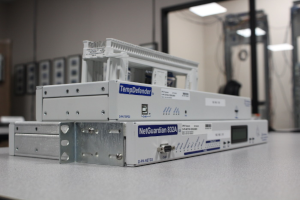Check out our White Paper Series!
A complete library of helpful advice and survival guides for every aspect of system monitoring and control.
1-800-693-0351
Have a specific question? Ask our team of expert engineers and get a specific answer!
Sign up for the next DPS Factory Training!

Whether you're new to our equipment or you've used it for years, DPS factory training is the best way to get more from your monitoring.
Reserve Your Seat TodayEvery May, the International Code Council (ICC) leads Building Safety Month, a campaign that highlights the importance of up-to-date codes, well-maintained infrastructure, and coordinated emergency planning. While much of the focus falls on architecture and construction, there's another side to safety that often goes overlooked: the systems quietly working in the background to detect, report, and respond to threats.
Facilities that demand 7x24 connectivity - whether telecom shelters, utility substations, or municipal command centers - depend on more than physical design. They must give you continuous visibility into what's happening behind the walls and inside the panels. That's where intelligent monitoring platforms come in.
Let's take a closer look at some of ICC's statements and particularly how it connects to alarm visibility, operational continuity, and the smart infrastructure tools that help keep modern buildings - and the people inside them - safe.

Building codes aren't just paperwork - they're actionable guidelines created to protect the people who live, work, and rely on the built environment every day.
"All communities need building codes to protect their citizens from hazards like fires, weather-related events and structural collapse."
This quote is a powerful reminder that safety is incorporated into design through regulation. But after a building is constructed, the work doesn't stop. Ongoing safety means adopting tools that help your facility stay in alignment with evolving standards - and that includes monitoring equipment.
Look for gear that can automatically report alarms, power loss, environmental changes, and equipment faults, so you're never relying on hope and luck to stay compliant. Systems that centralize alarm data into one platform make it easier to detect problems before they become emergencies.
When you have visibility of your critical infrastructure - from power supplies to water pumps to HVAC controls - you're reinforcing the exact type of resilience that ICC codes are built to promote.
A building may be "up to code", but that doesn't guarantee safety if the people managing it aren't aware of what's happening inside. Effective communication - between systems and personnel - is a defining factor in emergency readiness.
"Building safety professionals work day in and day out to keep the public safe."
Professionals across industries - technicians, facility managers, and first responders - make quick decisions based on the information they receive. If an alarm trips but no one sees it, or if a temperature spike in a telecom shelter goes unreported, the consequences can be severe.
That's why facility leaders increasingly turn to monitoring platforms with real-time alerts, visual dashboards, and prioritized alarm sorting. Whether you're coordinating a fire drill or responding to a live threat, instant insight into the problem - along with where it's happening and how critical it is - gives your team the clarity they need to act quickly. Well-integrated systems can make the difference between a minor incident and a major outage.
Strong safety culture doesn't come from technology alone. It's built when everyone in the organization has access to the information they need to contribute.
This actually reminds me of a late-2021 visit I made to a DPS Telecom client operating a large mining facility. The company's commitment to safety was evident from the moment we arrived, as we were required to adhere to rigorous COVID-era protocols, including health screenings and mask usage.
Before entering the site, our California-based team also received detailed road-safety guidance, emphasizing the importance of obeying speed limits and proper vehicle inspections to prevent accidents on the challenging terrain.
From IT to maintenance to admin staff, shared situational awareness can drive faster, more effective responses.
"We all contribute to making sure the places where we live, work and play are safe... even the smallest action can ultimately save lives."
Monitoring tools that feature simple visual indicators and intuitive interfaces allow even non-technical users to spot when something's wrong. If a certain room detects smoke or flooding unexpectedly, staff should be able to recognize that issue and report it - regardless of their technical background.
With centralized alarm systems that use plain-English summaries, color-coded prioritization, and zone labeling, it becomes easier for everyone to stay engaged in safety. This reduces blind spots, empowers early intervention, and creates a team-wide culture of vigilance.
Emergency plans are only useful if you know when to execute them. In facilities that support critical services - telecom, utilities, emergency communications - reacting only a few minutes earlier can make all the difference.
"Know your risks. Make a plan. Take action."
Preparedness isn't just about having some binder on a shelf collecting dust. It's about integrating alarms and triggers that align with your emergency protocols. When you receive a real-time alert that a backup generator has failed or that a high-humidity condition is threatening electronics, your team can jump into action based on a known plan.
Look for monitoring systems that support remote relays, so you can take action even if you're off-site. Whether it's cutting power to a faulty unit or turning on a secondary cooling system, automated responses backed by real-time data can help prevent loss and protect personnel.
One of the most persistent threats to any facility is fire - and while codes address detection and suppression systems, actual protection depends on monitoring continuity.
"Put a smoke alarm on every level... Test each smoke alarm regularly and keep batteries fresh by replacing them annually."
Just as residential fire safety relies on working smoke alarms, commercial and industrial facilities require always-on visibility into smoke detectors, suppression gear, and flow switches. But regular testing isn't always enough. Systems must notify staff the moment something goes offline or enters a trouble state.
In complex environments - especially those across wide areas - a centralized alarm master system can make sure that no event goes unnoticed. Integrated alerting for sprinkler flow, tamper switches, and water pressure loss adds another layer of protection to existing suppression efforts. Safety professionals can't be everywhere - but monitoring systems can.
The T/Mon, for example, is a centralized master station that consolidates alarms into a single, intuitive interface. It continuously polls connected devices, instantly reporting abnormal conditions - like an offline device or high heat - before they escalate into emergencies.
It's important to remember that general-purpose alarm masters like T/Mon may not be UL-listed or ETL-listed. They might play an ancillary function to give you additional visibility and potentially integrate fire alerts into a broader monitoring umbrella, but compliance with fire code typically requires at least some UL-listed equipment.
Bringing a facility in line with current code isn't just a matter of compliance. It's an investment in reliability, efficiency, and long-term performance.
"Updating existing homes and buildings to modern building codes can reduce utility bills, insurance premiums, and repairs and maintenance."
Modern monitoring infrastructure provides benefits that extend beyond emergency response. Fewer truck rolls, faster fault isolation, and data-driven maintenance all contribute to lower operating costs. And since many systems support legacy integration, transitioning to a modern platform - like T/Mon LNX - doesn't have to mean replacing every piece of old equipment.
Facilities that modernize are also better positioned to incorporate energy-efficient HVAC, environmental controls, and remote access features that support both sustainability and resilience. It's the kind of win-win that code updates sometimes help enable.
Finally, even the best system is only as effective as the people using it. Building safety professionals need tools that are as user-friendly as they are powerful.
"Building safety professionals... train constantly to keep up with the latest codes and standards."
That's why alarm systems should feature custom instructions, programmable responses, and training modes that help new staff get up to speed quickly. With support for audit logging and historical review, teams can evaluate past events, run simulations, and continuously improve response protocols.
This makes ongoing education part of the system - not an afterthought. And when your team is prepared, your entire facility becomes safer.
T/Mon LNX supports real-time notifications, color-coded alarm priorities, and automated escalation logic, which ensures that fire-related events are not just detected, but acted on with speed and clarity.
The master station also maintains detailed logs for audits and post-incident reviews. This helps you meet both safety standards and code compliance requirements without relying solely on manual checks.
Building Safety Month serves as a reminder that safe buildings require both structural integrity and operational awareness. While codes provide the blueprint, monitoring systems provide the feedback loop. Together, they create safer, more resilient spaces.
If you're responsible for the safety of a networked facility - telecom, power, transportation, or municipal - consider the tools you use to stay informed. Look for alarm systems that centralize data, alert staff instantly, and adapt as your facility grows.
And when you're ready to modernize your approach, DPS Telecom offers the technology and experience to help you keep your mission-critical facilities online and maintain safety for your staff and (when applicable) the general public.
We'll help you design a system that aligns with ICC goals while protecting your team, your equipment, and your mission.

Andrew Erickson
Andrew Erickson is an Application Engineer at DPS Telecom, a manufacturer of semi-custom remote alarm monitoring systems based in Fresno, California. Andrew brings more than 18 years of experience building site monitoring solutions, developing intuitive user interfaces and documentation, and opt...